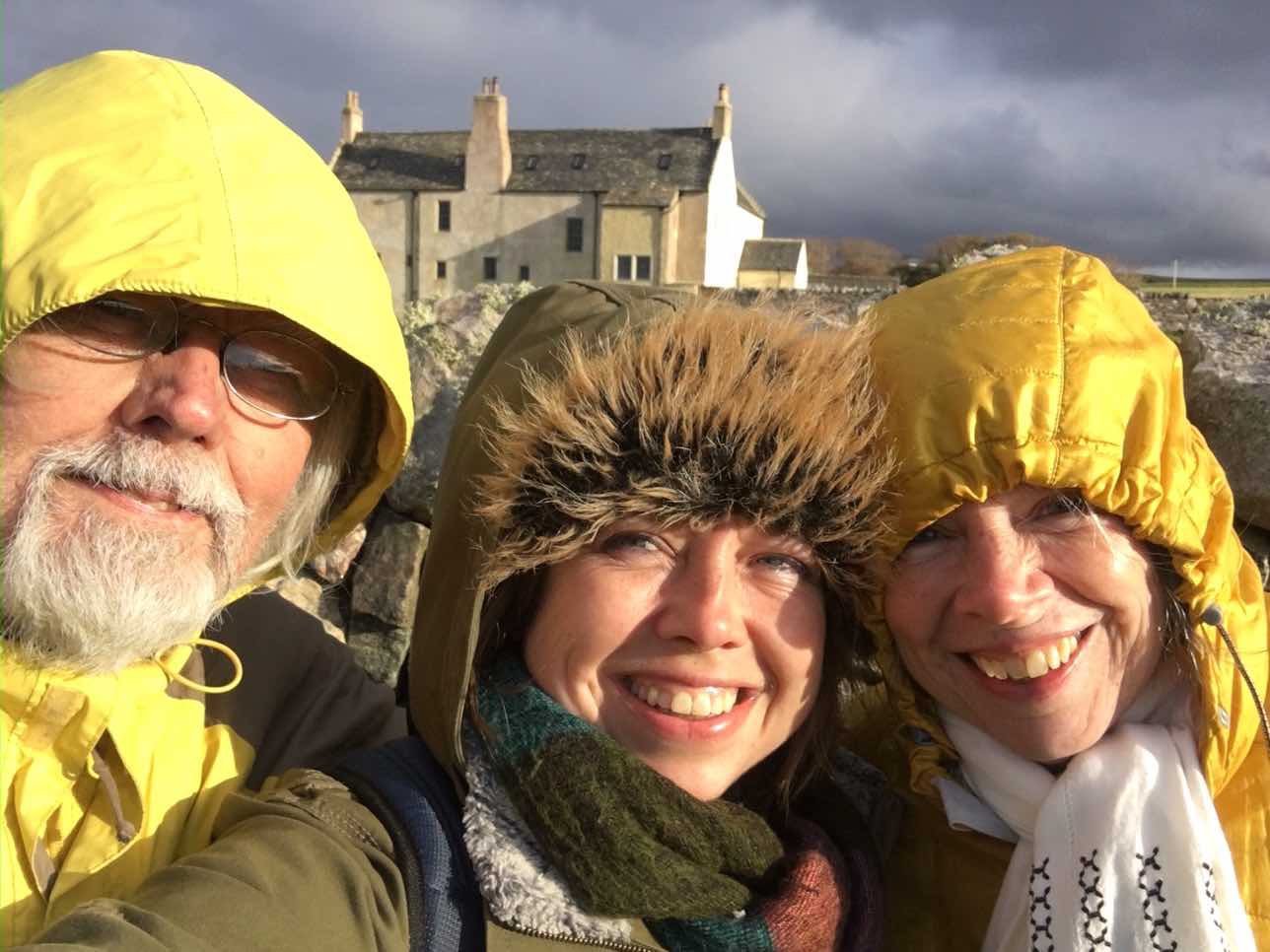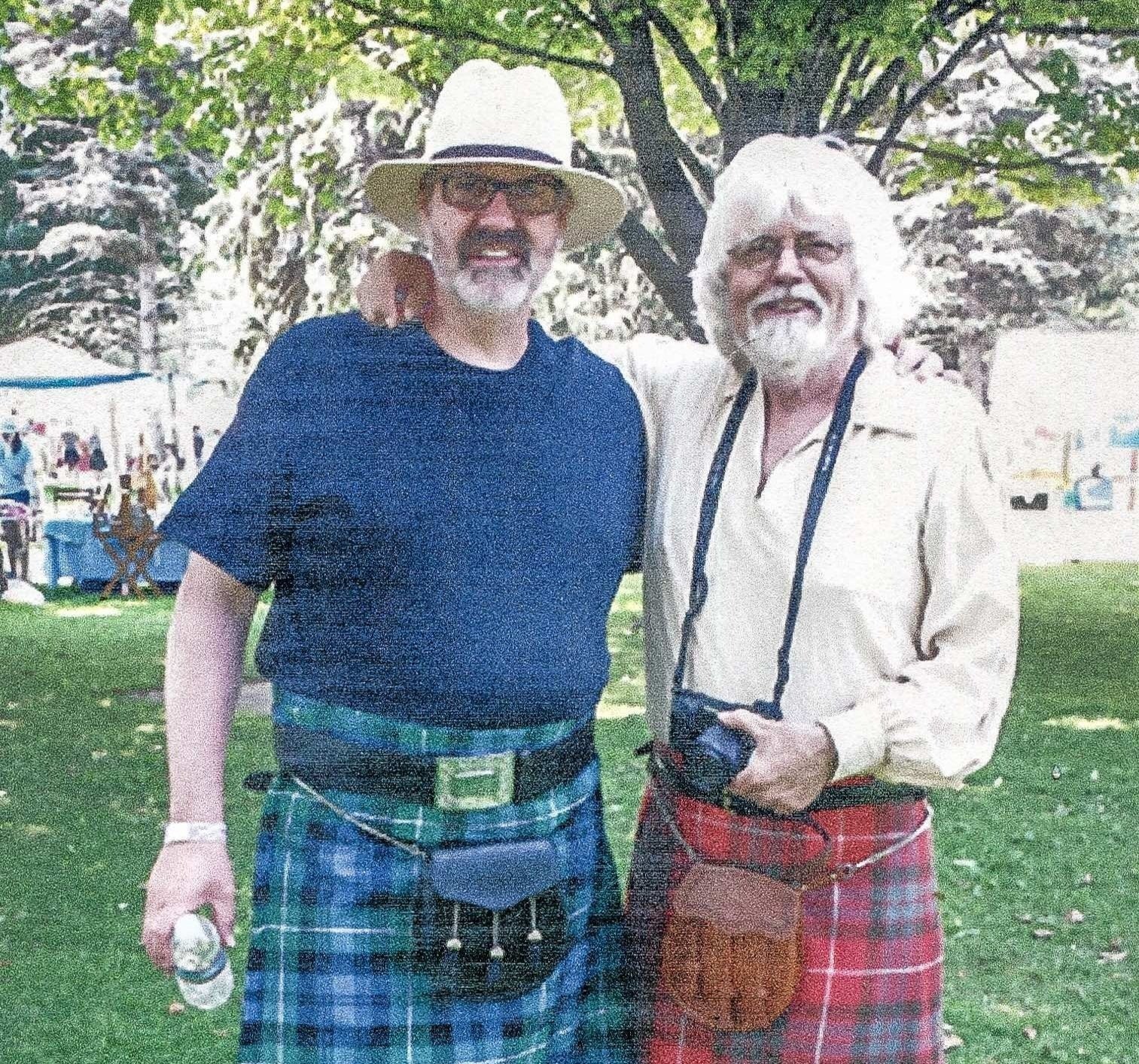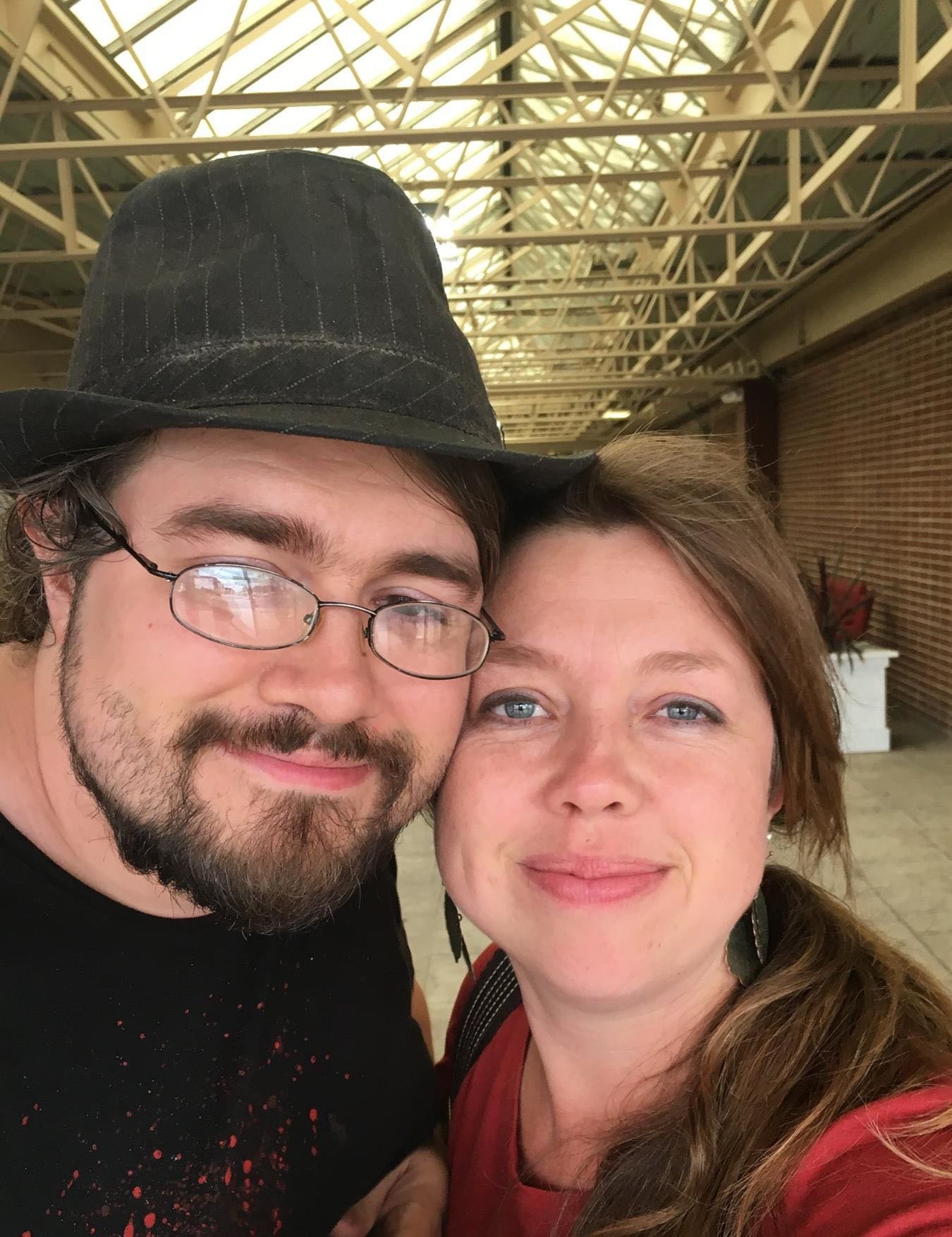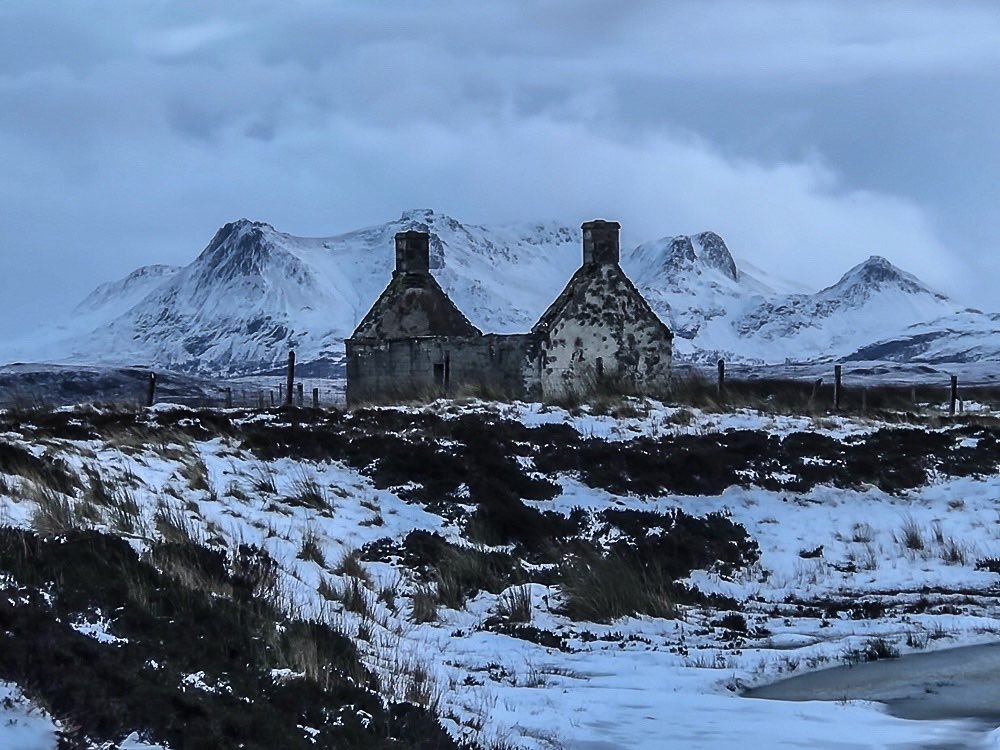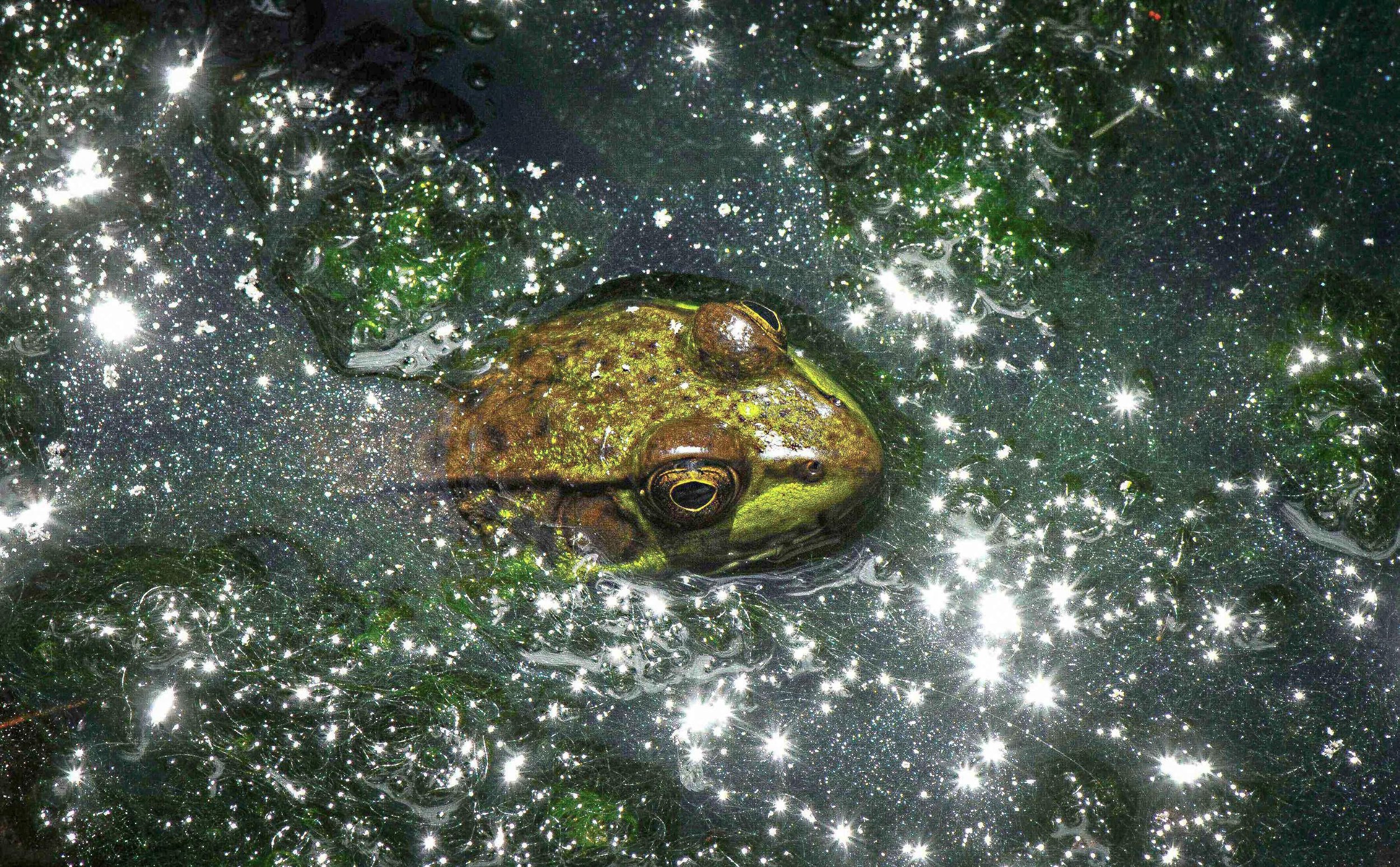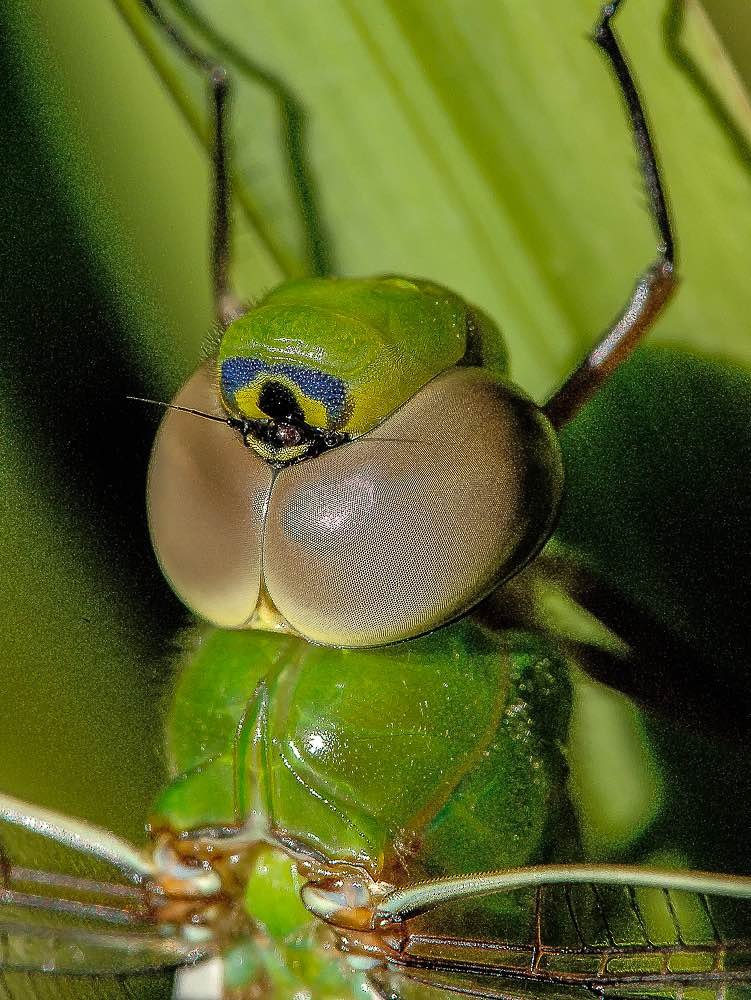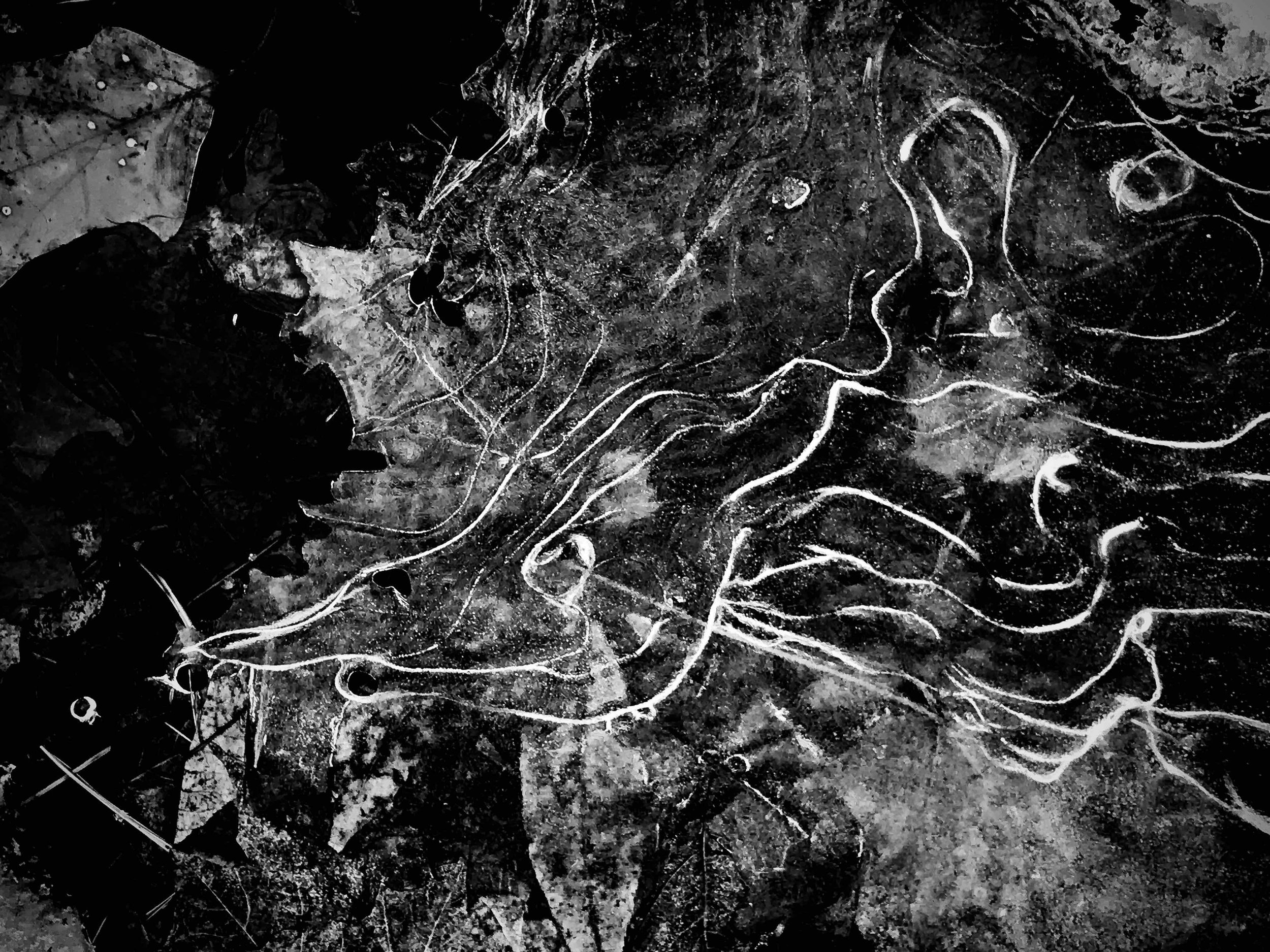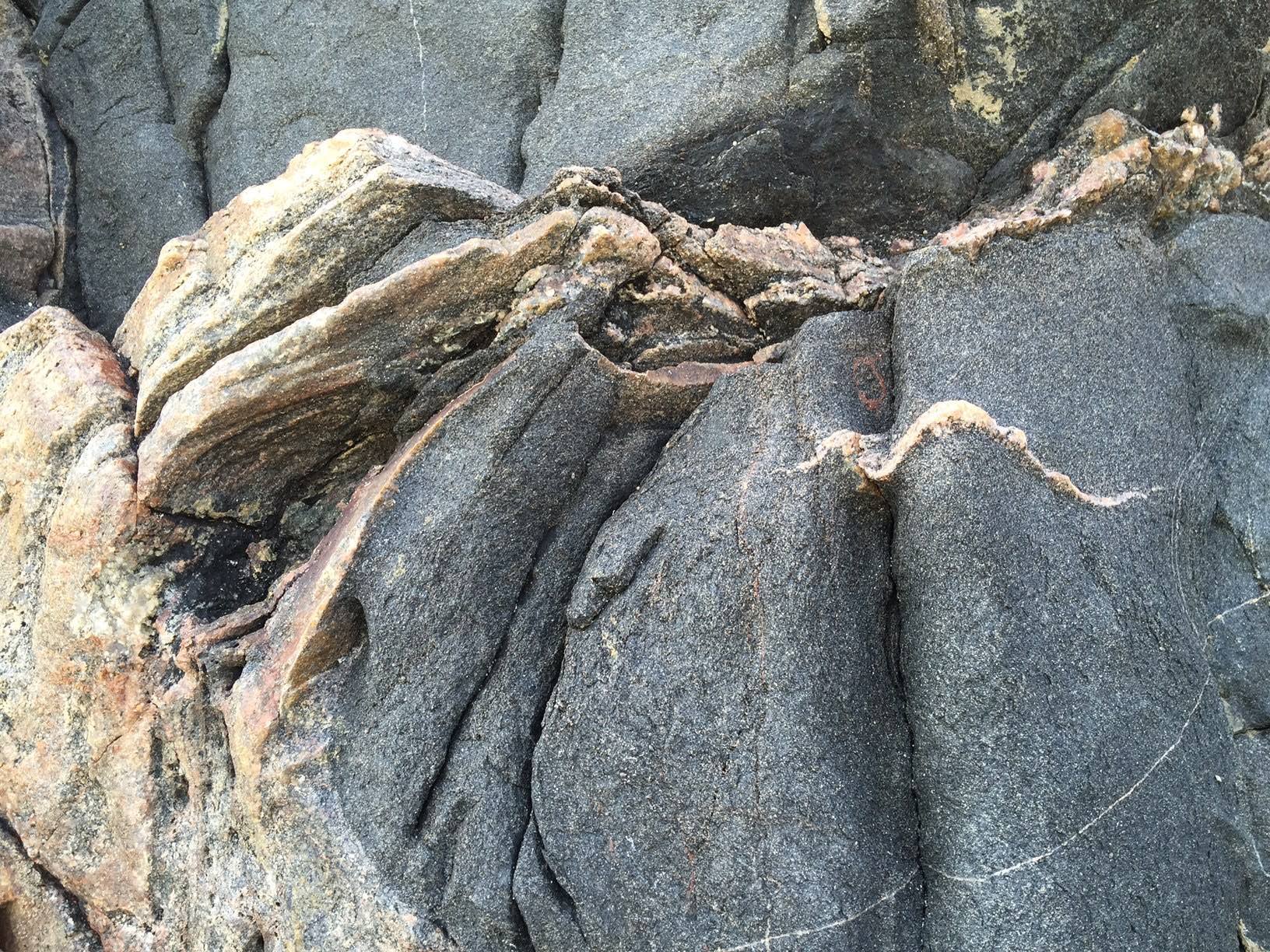A wee chat…
Eric Hilton has an exuberance that is cosmic in proportions. He is full of Scottish mirth, but also deeply thoughtful about nature, humanity, and the role of art in understanding both. All of it is so contagious that within minutes of “a wee chat” with him, you will find yourself laughing out loud and climbing inside your mind about profound philosophical stuff.
Hilton’s father worked in the clothes trade and had a knack for making vibrant shop window displays; his mother was a seamstress and knitter. He was five years old in London when World War II began and air raids dropped bombs all around them. When the house across the street was hit, the reverberations shattered their windows, forcing them to take refuge in an Anderson shelter. Before long, they went to live with his grandfather in Scotland (as a side note, Hilton recalls vividly how their train was attacked en route and bullets flew by the windows of the stopped cars).
Hilton working
As far back as he can remember, Hilton was always drawing, always “plunking things on paper.” He loved to draw birds, from books or inspired by his frequent walks in the local woods in Falkirk, near Glasgow, where they eventually moved. He was proud of those drawings until one day he bumped into another kid who, as it turned out, also liked to draw. Back at the boy’s house, Hilton saw his elaborate and expert drawings of battle scenes, knights, and horses and was filled with jealousy. Both men ended up doing glass at Edinburgh College of Art, remaining in fraternal competition throughout.
Hilton still loves to draw and still loves walking the woods, which these days occurs mostly on the 65-acre property in upstate New York where he has lived for 40 years with his wife, Sarah Schantz (on land originally purchased by her parents). Hilton designed their house and built it together with friends, and when he had enough money, he added a studio up in the hills. He lives and works in communion with the natural world. Each time he walks in his woods, they are changed. That cyclical and temporal character is endlessly fascinating to Hilton, whose art explores physical elements, metaphysical energies, and the interdependence of the two. He is drawn to the infinity of the universe, to the mysteries of existence which he constantly investigates, records, absorbs, then interprets in glass.
One day years ago, while instructing students at Alfred University in loading a kiln, Hilton was approached by the president of Steuben Glass and invited for a chat at their headquarters. It was a lunch meeting in the executive lounge, and they had to lend him a tie since he showed up sporting long hair and a hippie shirt. They proposed he submit some design ideas. He had just purchased a derelict property in northern Scotland, its 250-year-old neglected stone house overlooking the Atlantic and the mountains, so he went to Scotland to fix the house and work on some drawings. He trudged to the local post office to send them to America (a place he was pretty sure the postman had never heard of), but three weeks later the drawings came back to him, worse for the wear, and marked “insufficient postage.”
A second batch of drawings made it safely to New York and soon a telegram arrived offering a role as a design consultant and word that a ticket back to America awaited him at the Edinburgh airport. Over forty years later, Hilton is one of Steuben’s most renowned artists; his affiliation with them has produced stunning collectors’ pieces and significant sculptural projects both in the United States (such as Innerland, from 1980) and abroad (such as Creation, first exhibited at the 1990 World Exposition in Osaka, Japan). He used their facilities to create the board room doors at S.C. Johnson’s Council House. From the beginning, Steuben always allowed him room for his own work, letting him loose in their blowing rooms and providing access to tools and equipment he could not afford early in his career. As in independent artist in his own studio, Hilton has among many his many other works executed some dramatic architectural commissions, including sculptures at Rockefeller Center, Queens College in New York, on a cruise line, and in private residences.
A SELECTION OF COMMISSIONS BY ERIC HILTON
Door Double Threshold; Johnson Boardroom Doors; Rockefeller Commission; Phoenix; Vesica; Steuben, Flight of Eagles; Steuben Corporate Sculpture.
In concert with the rugged individual who thrives in wild isolation is an affable and curious artist and experimenter. He is a man of immense technical skill who builds his pieces gradually and thoughtfully through the often frustrating but always satisfying process of molding, etching, cutting, sandblasting, and polishing. Hilton’s glass art pulses with the dramatic light of his native landscapes and resonates with the soulful vitality of his subjects—from animals to the seasons, from geometric abstractions to the cosmos, from mental landscapes to storybook characters. Within each piece are arteries for light and reflection and pathways for the exploration of physical, psychological, and spiritual concerns.
Hilton believes that art creates connections between people. He collaborates with creative types of all stripes from glassblowers to woodworkers and engravers. One of his most invigorating and experimental partnerships is with James Allen, a friend in high-tech with professional credits at NASA and IBM. Allen is also a digital artist, and the two are currently working on a sculpture commission for a homeowner of a converted church, creating an abstracted family portrait in glass where the faces appear and disappear within colorful pathways carved into the material to express familial connections and energy.
Earlier this year, Hilton teamed up with glassblower George Kennard in a live demonstration at Corning, during which they used a special tool to combine two glass bowls together. Little moments like this are meaningful to Hilton, who acknowledges the hundreds of people who used that tool before him and the aura this history endows it with. Similarly, when today he enters the auditorium at Steuben, located in what used to be the factory floor, he can feel the artisans and craftsmen who labored there for so many years. Just as Hilton recognizes the reciprocity between the glass artist and his medium, and the glass artist and his tools, he honors the meeting of the minds between the artist and the viewer. Not surprisingly, he enjoys talking to people about his work. His repertoire of playful stories and charming expressions makes him easy company, but beyond that he appreciates how people personalize a work of art with their own perspective and how art inspires people to new ways of seeing.
Two sides of Spun Metamorphosis, 28.5 x 24 x 7" , made with George Kennard at Corning. Video available HERE
Available Work
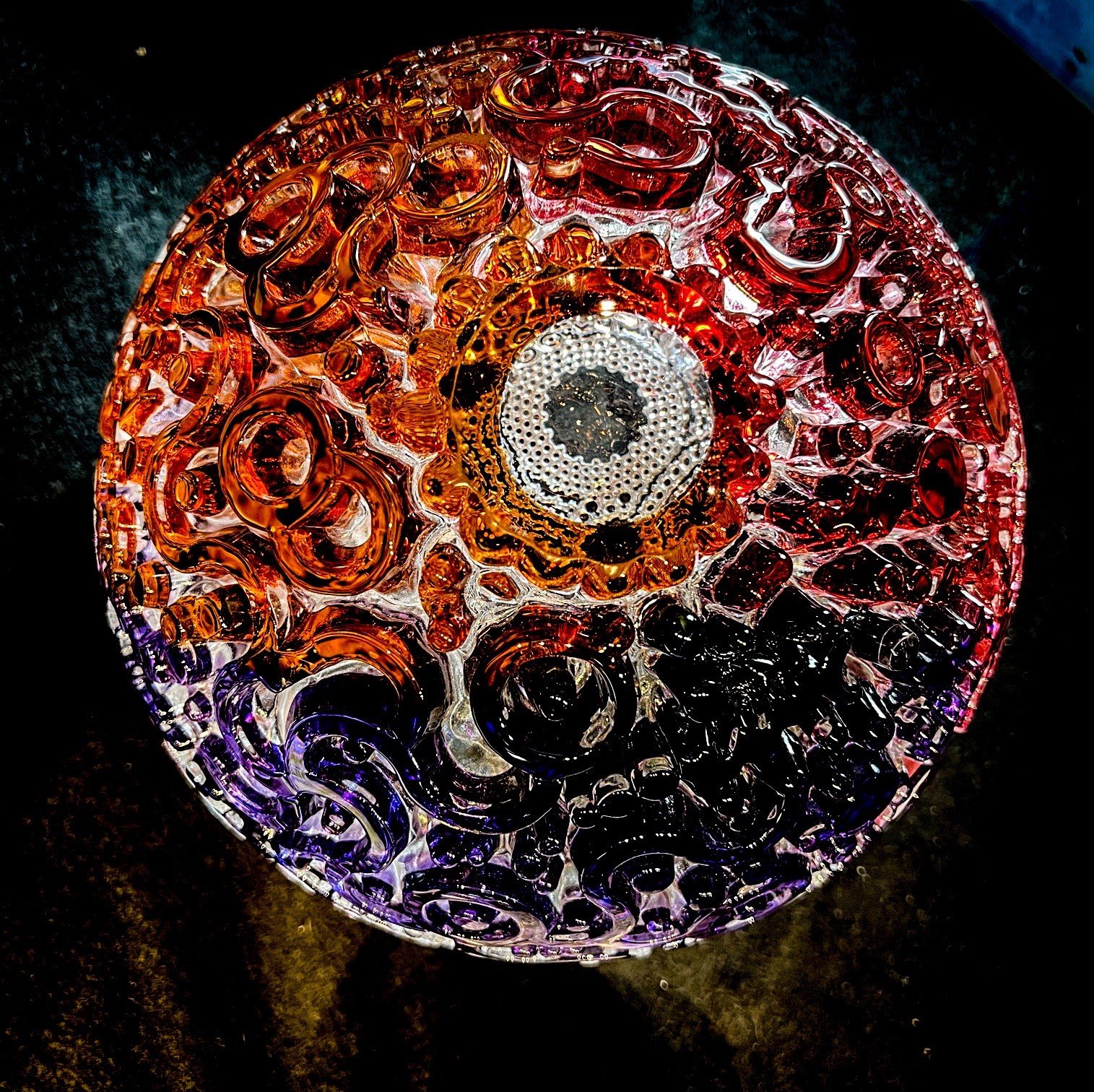
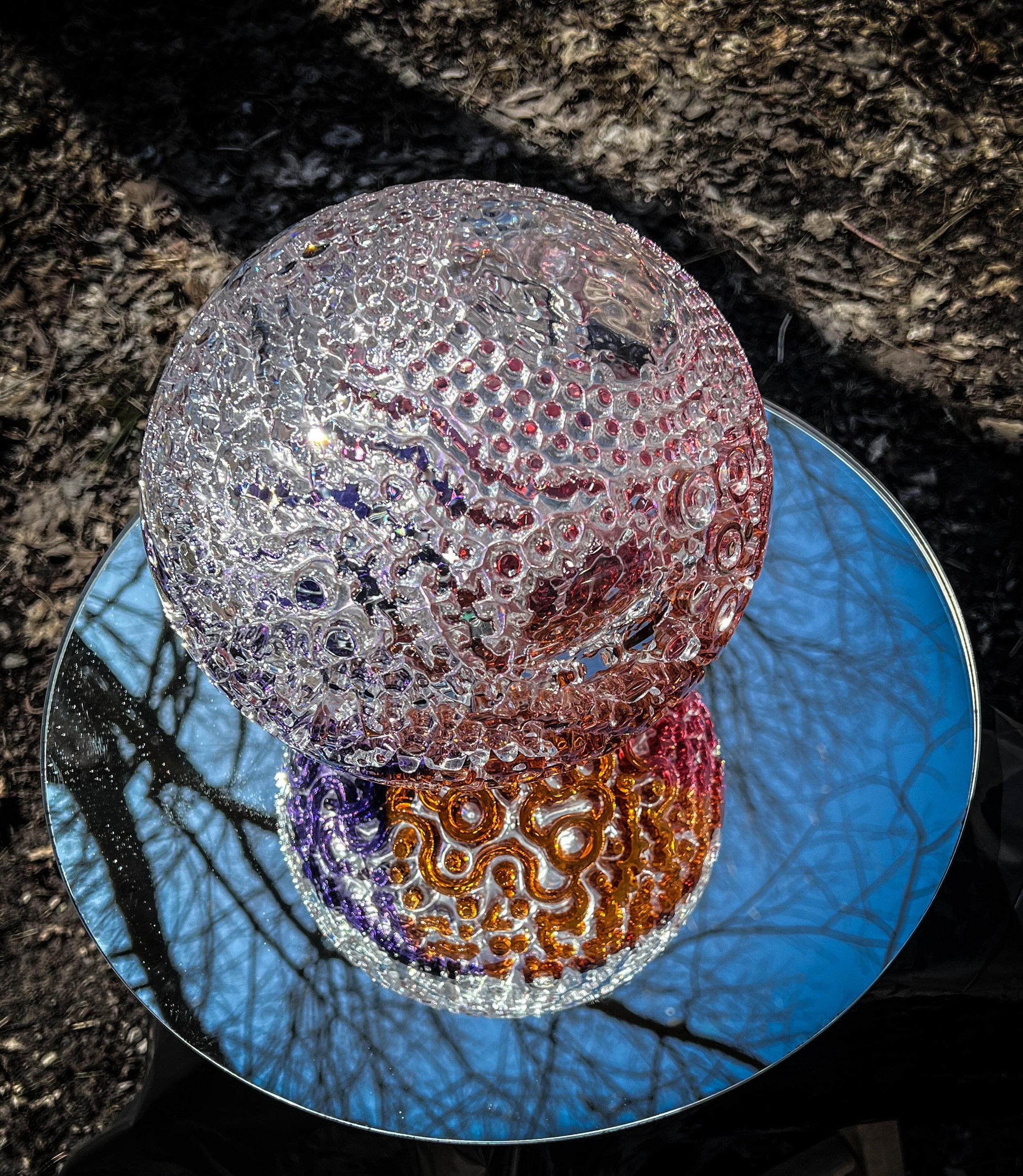
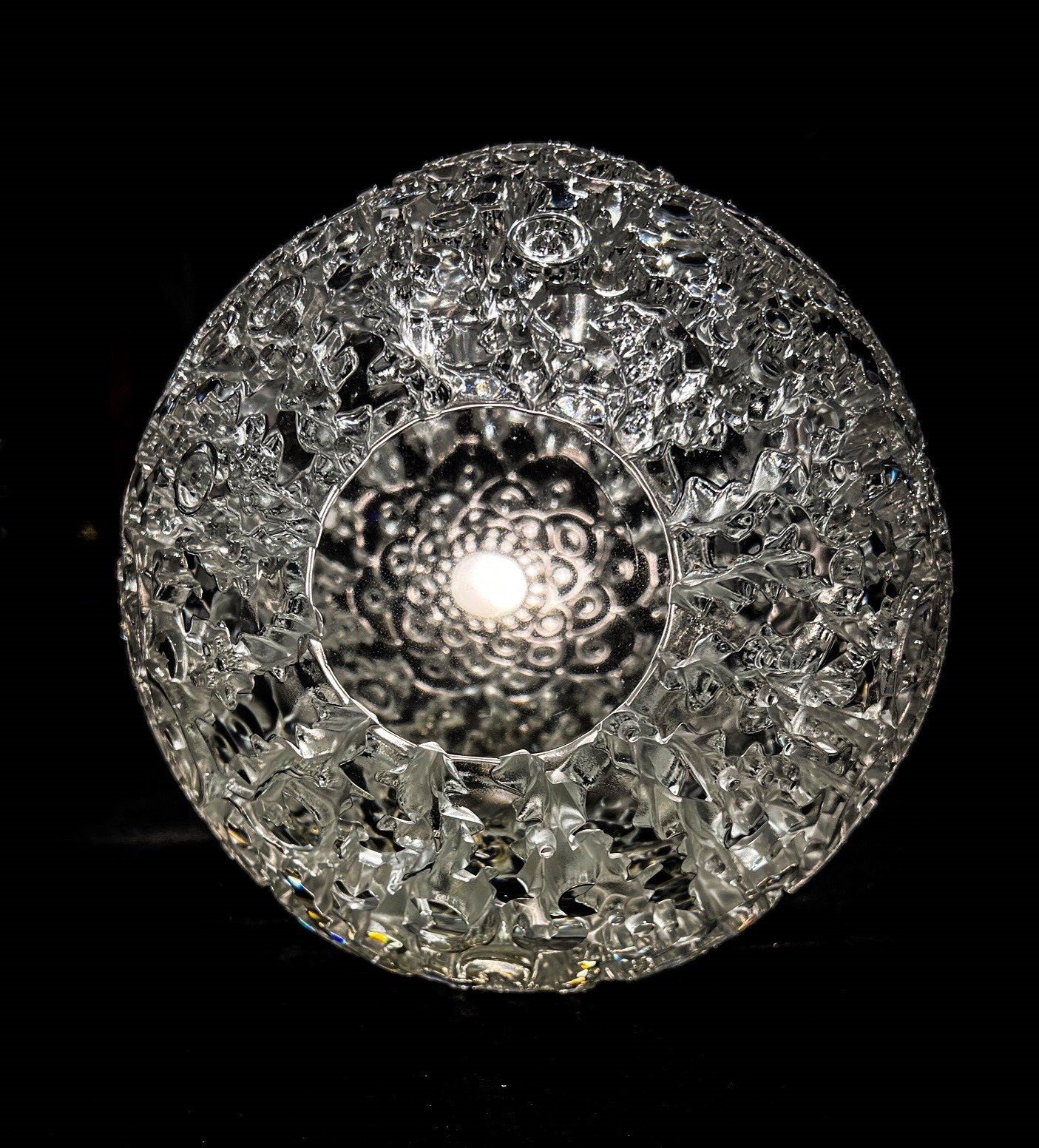
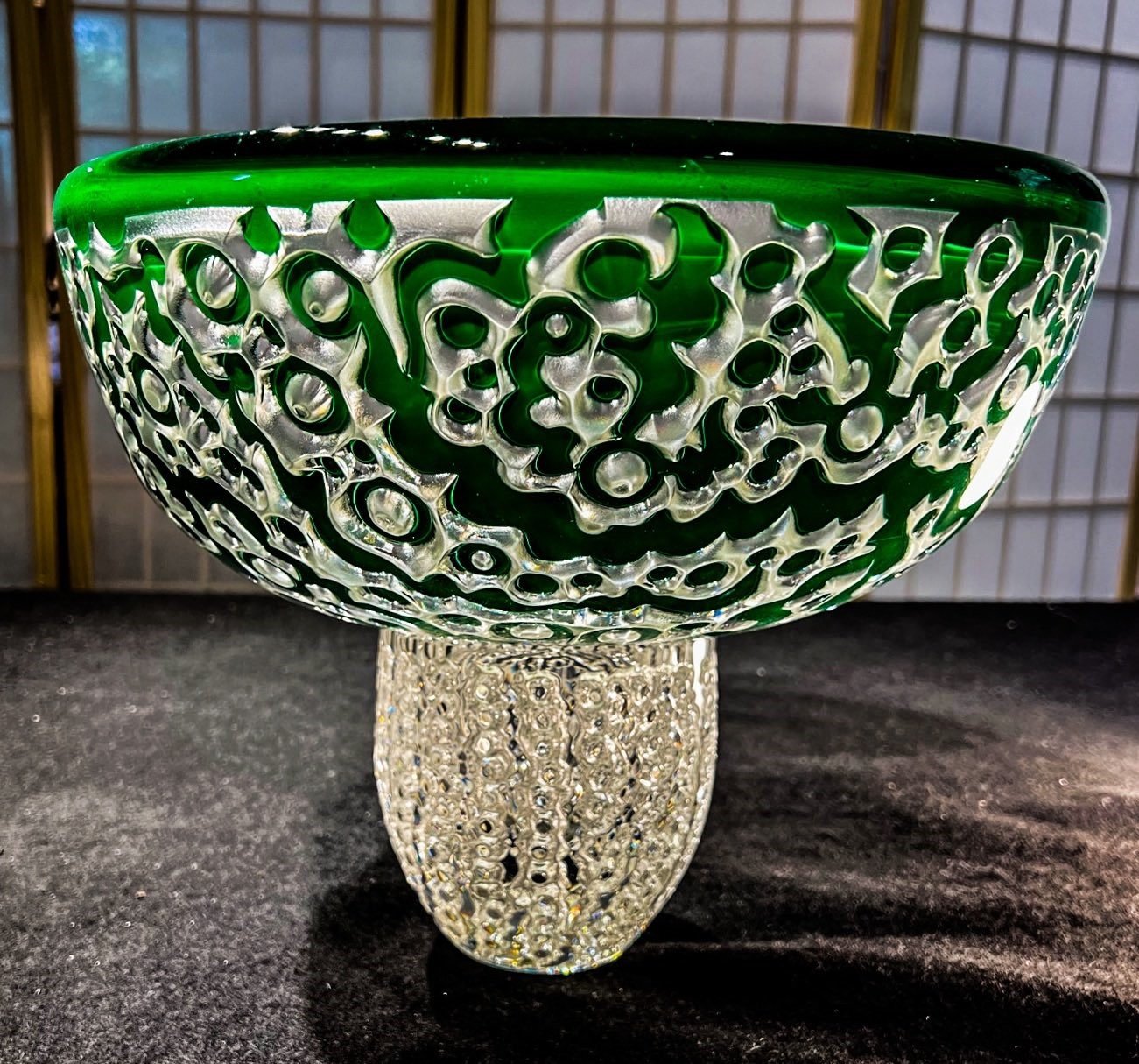
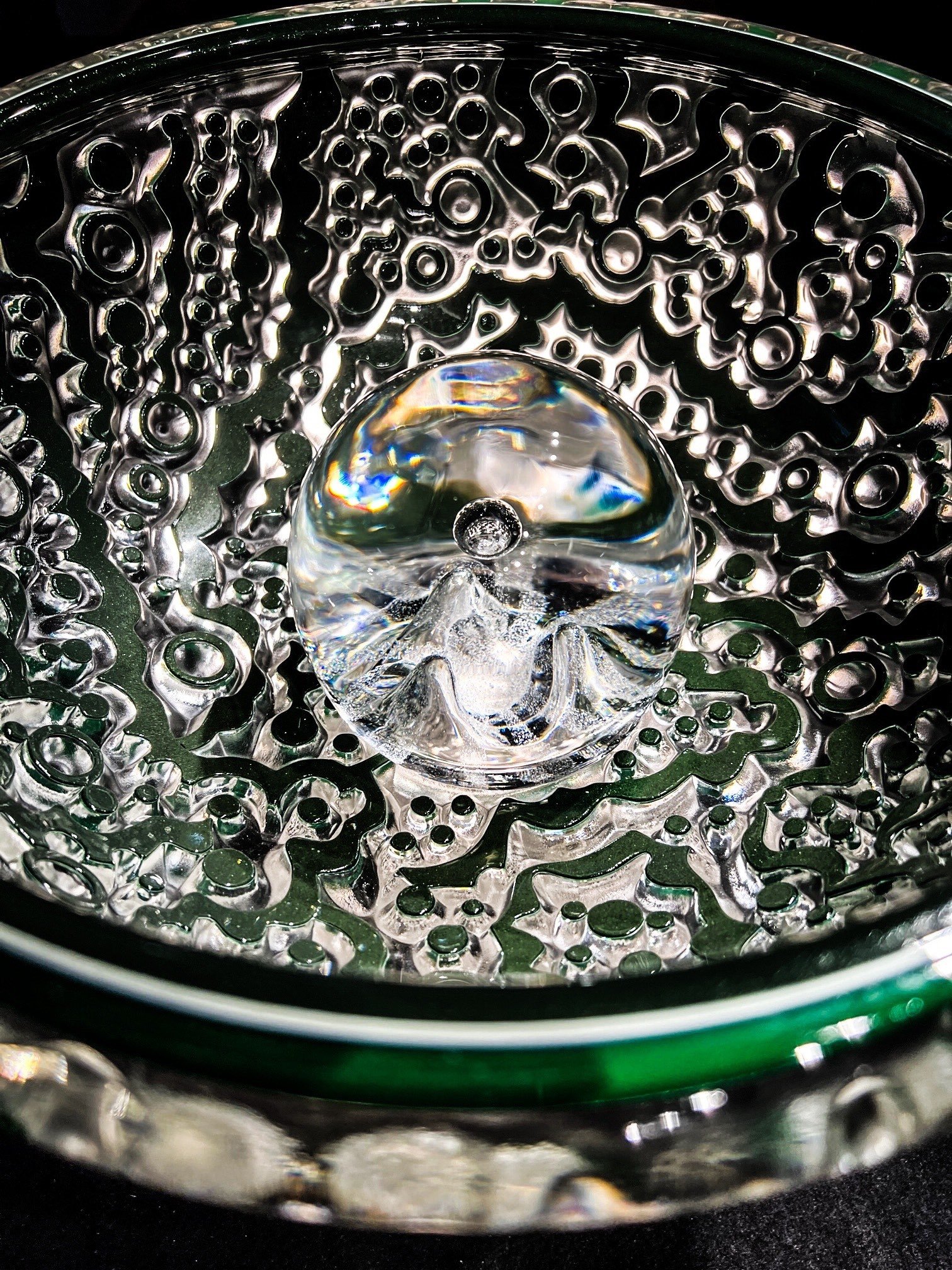
Friends, Family, and Canines
Meanwhile, he needn’t go far for personal or creative enrichment. His wife Sarah was an art student when they met at Alfred (she was his studio manager for years), plays music, loves to read, and does photography. His daughter, Erin, lives in the house that used to belong to Sarah’s parents before they passed away, and Hilton has given her “a patch in the studio” where she does incredible animal paintings. His son Kyle lives on the property, too, where among other things he does amazing drawings on his computer. He loves to have his “crazy, sweet, and kind” family close. Early in the pandemic, Hilton had his well-equipped studio to work in and would occasionally “nip out with a mask on” to meet with collaborators; he is now back to his usually busy schedule. Though the pandemic has temporarily halted visits to his magical little cottage in Scotland, he always feels close to his native land and his daily access to family, nature, and art keeps him in good humor. Have a “wee chat” with him, and you’ll undoubtedly emerge a fair bit lighter and whole lot wiser, too.
Hilton takes countless photos of life’s endless inspiration.
Abandoned Ghosts; Cosmic Frog; Dragonfly Eyes; Future: Ice Drawing; Oldshoremore Rocks.
ABOUT THE ARTIST
Scottish Artist and Designer Eric Hilton is a skilled master at working glass to convey the aesthetic and philosophical issues that confront artists. “Art for me is a vehicle that synthesizes order into the awe of existence. It is the vehicle for dance, music, poetry, literature and the visual arts. It represents the soul of human consciousness.”
Eric’s true passion is in the creative process in the molding, etching, cutting, sandblasting and the polishing of each work. His process is like painting, as he builds each piece gradually etching and cutting his detailed imagery and patterns over the whole surface. You can find the elements of life – earth, air, fire, and water in his work. “I am influenced by nature from which infinite information can be gleaned.”
Through reflection and refraction, lines he cuts with a copper wheel seem to travel from one surface to another, creating an imaginary landscape or map for the mind to travel. Works by Eric have a touch of the magic of ancient times as well as the futuristic plans for places yet to be explored. Scotland has a rich history of tales and Eric Hilton is a great teller of them, both through his art and his wonderful sense of humor and deep appreciation for the mysteries of life.
Cosmic Energy

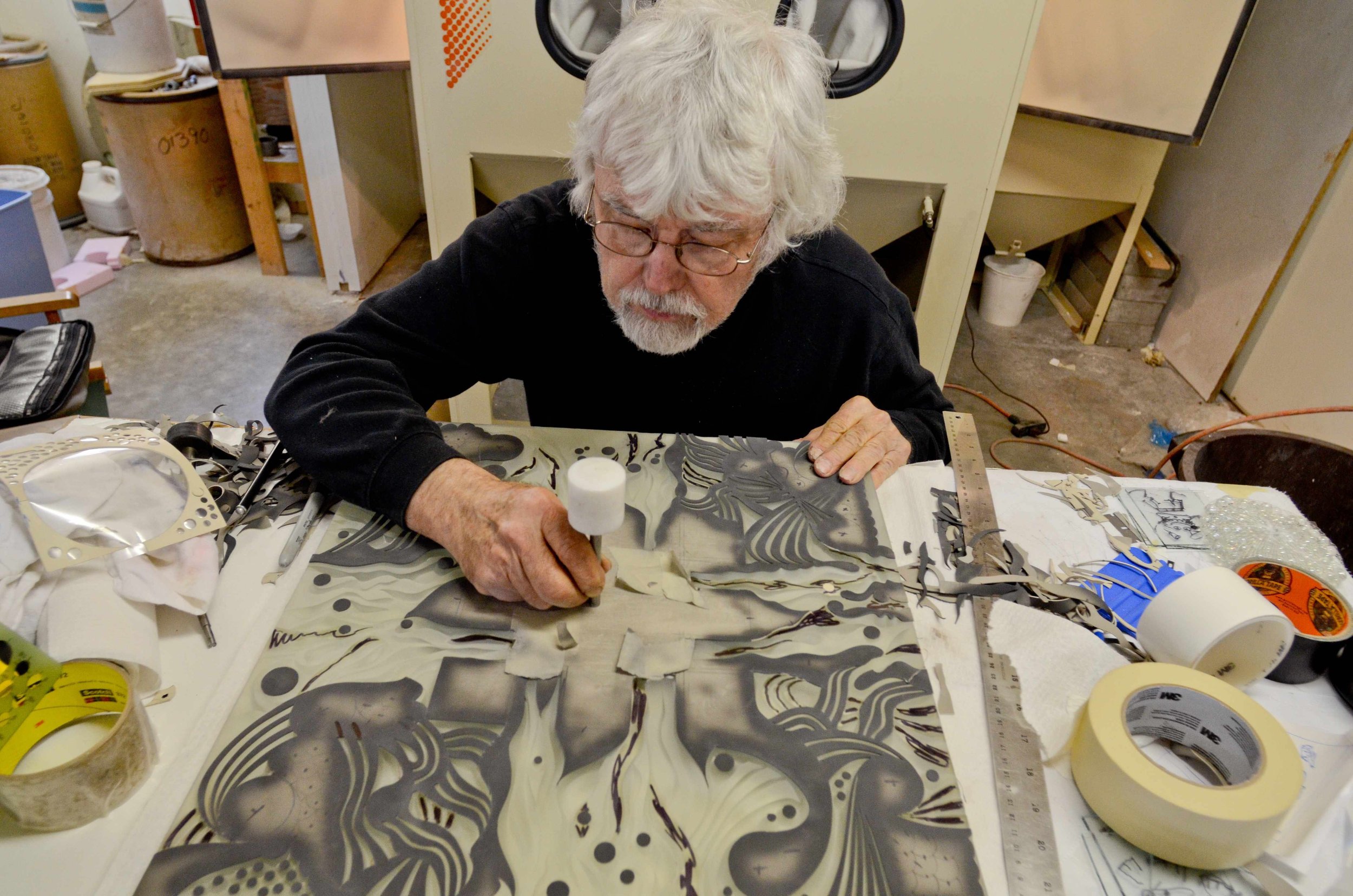

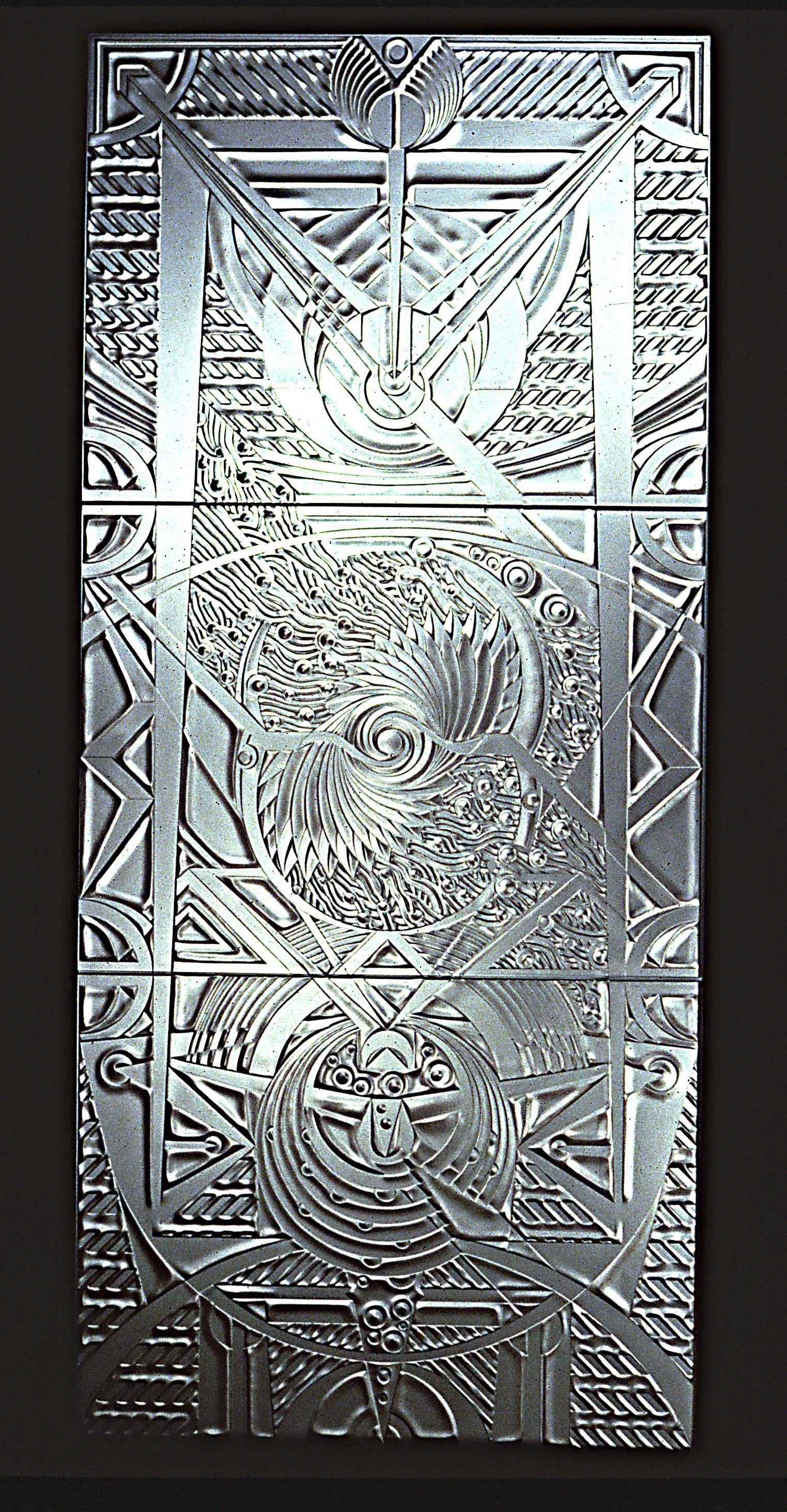
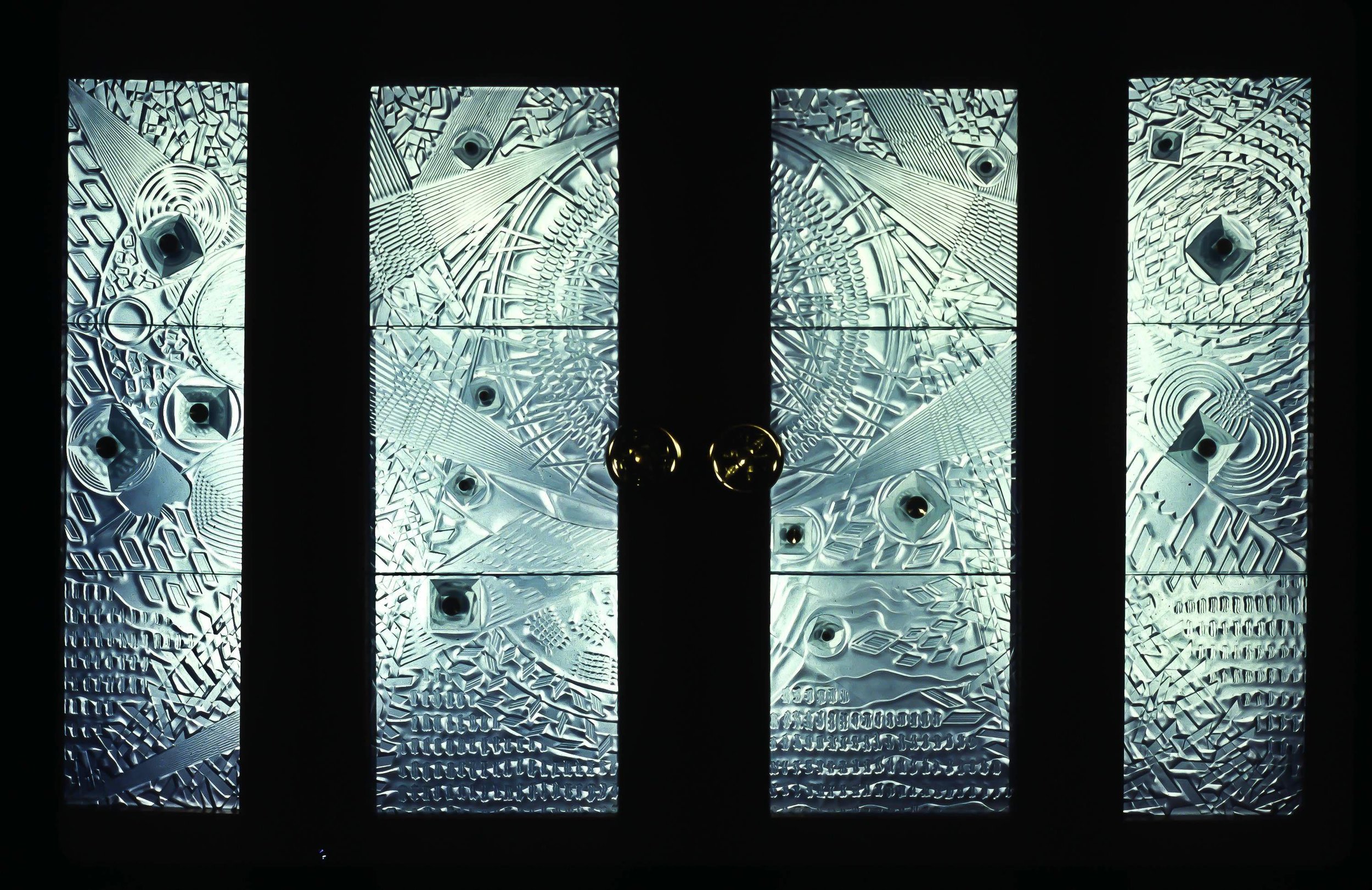
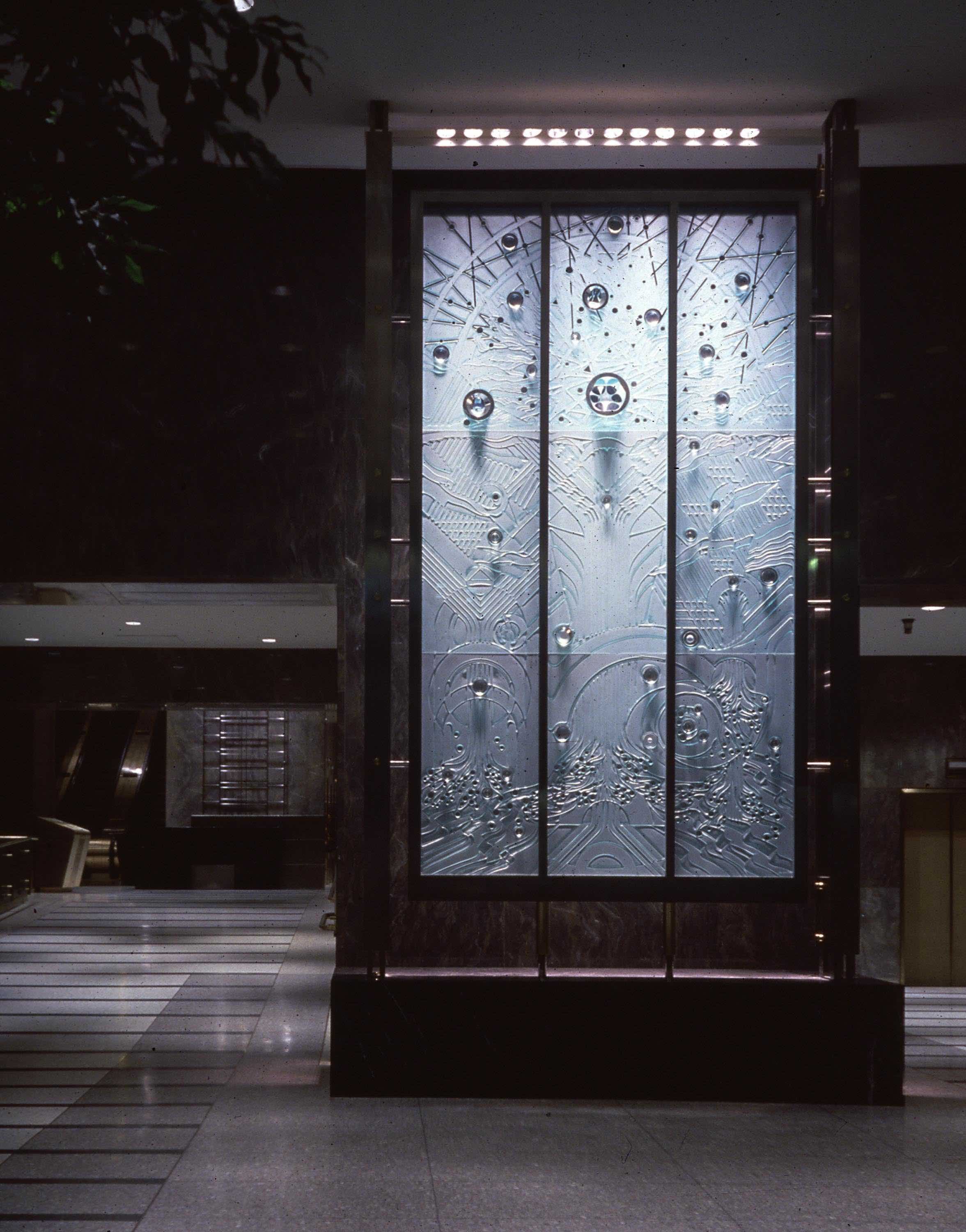
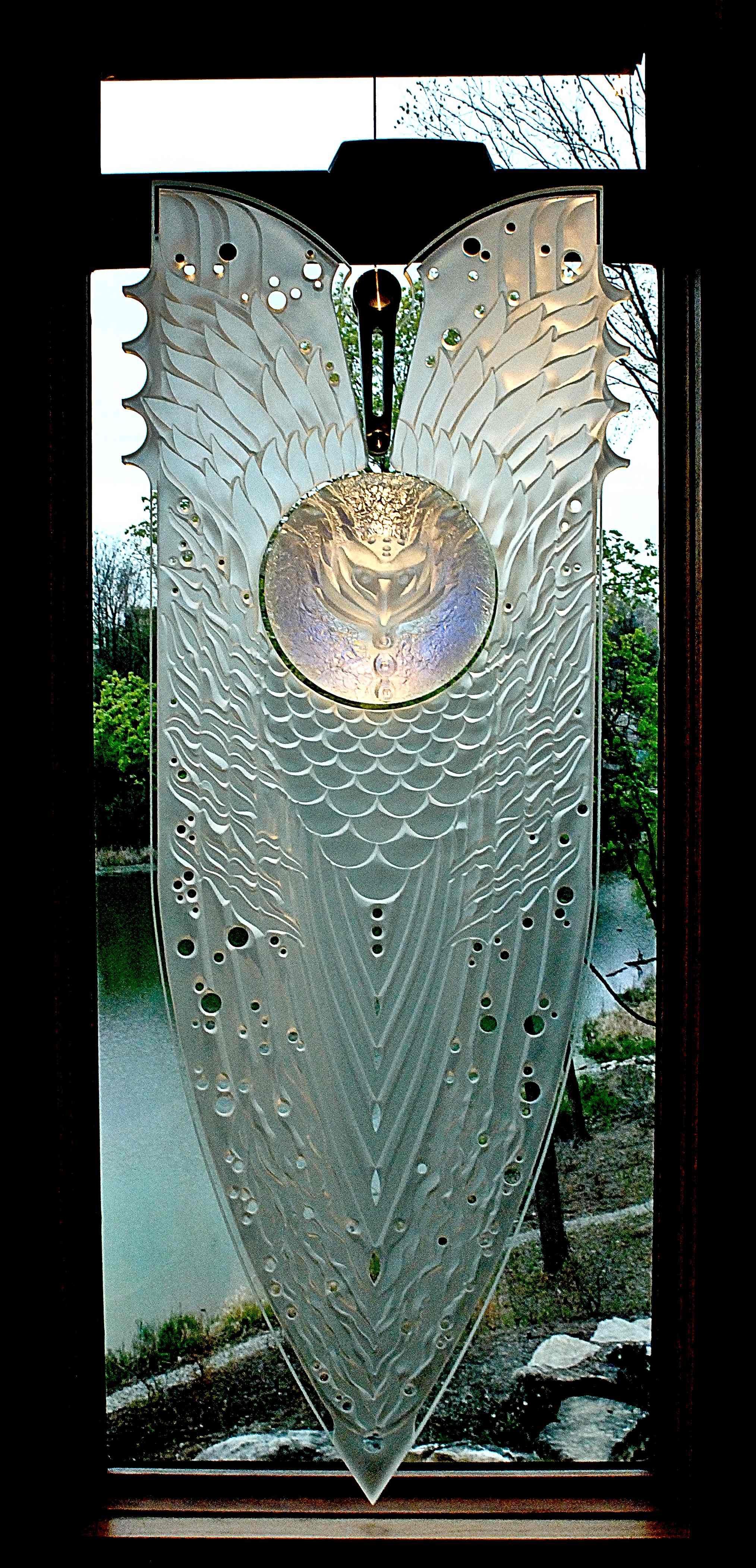
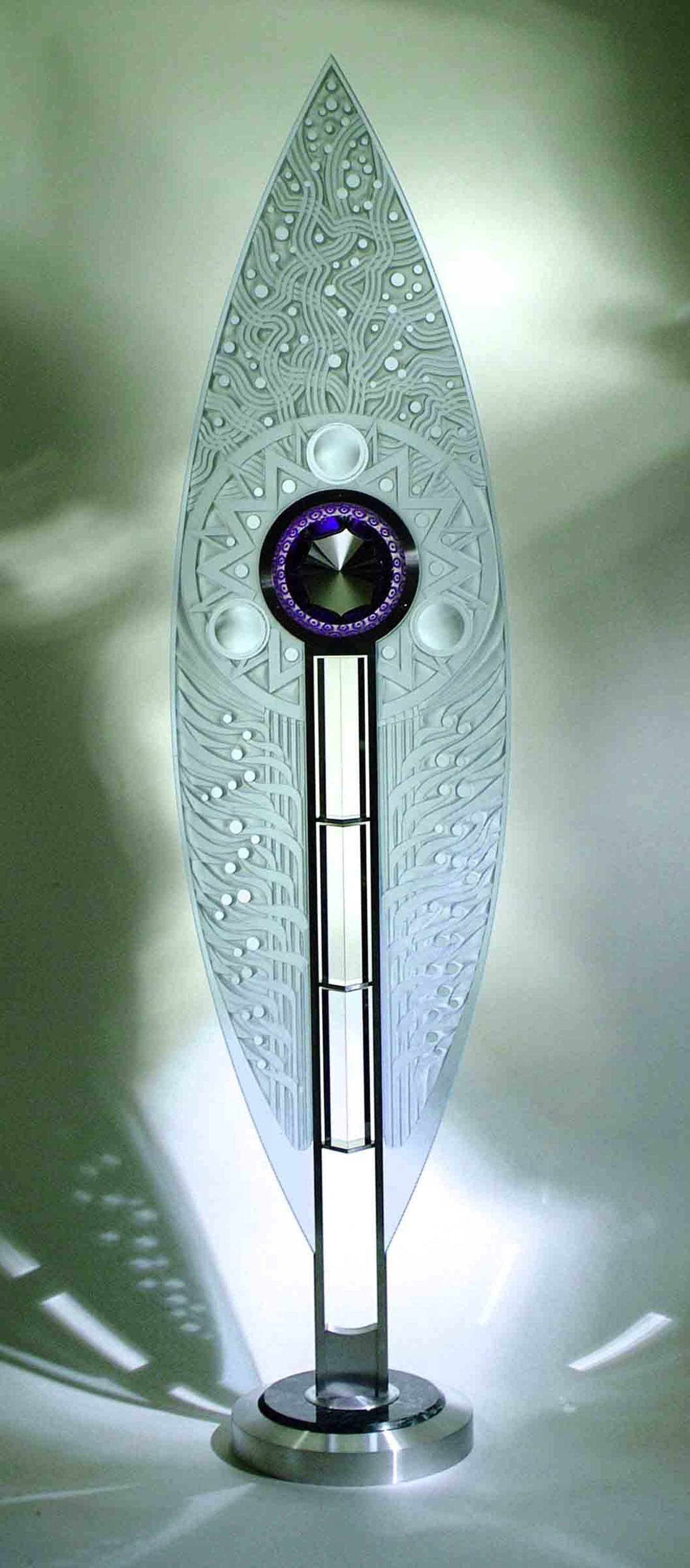

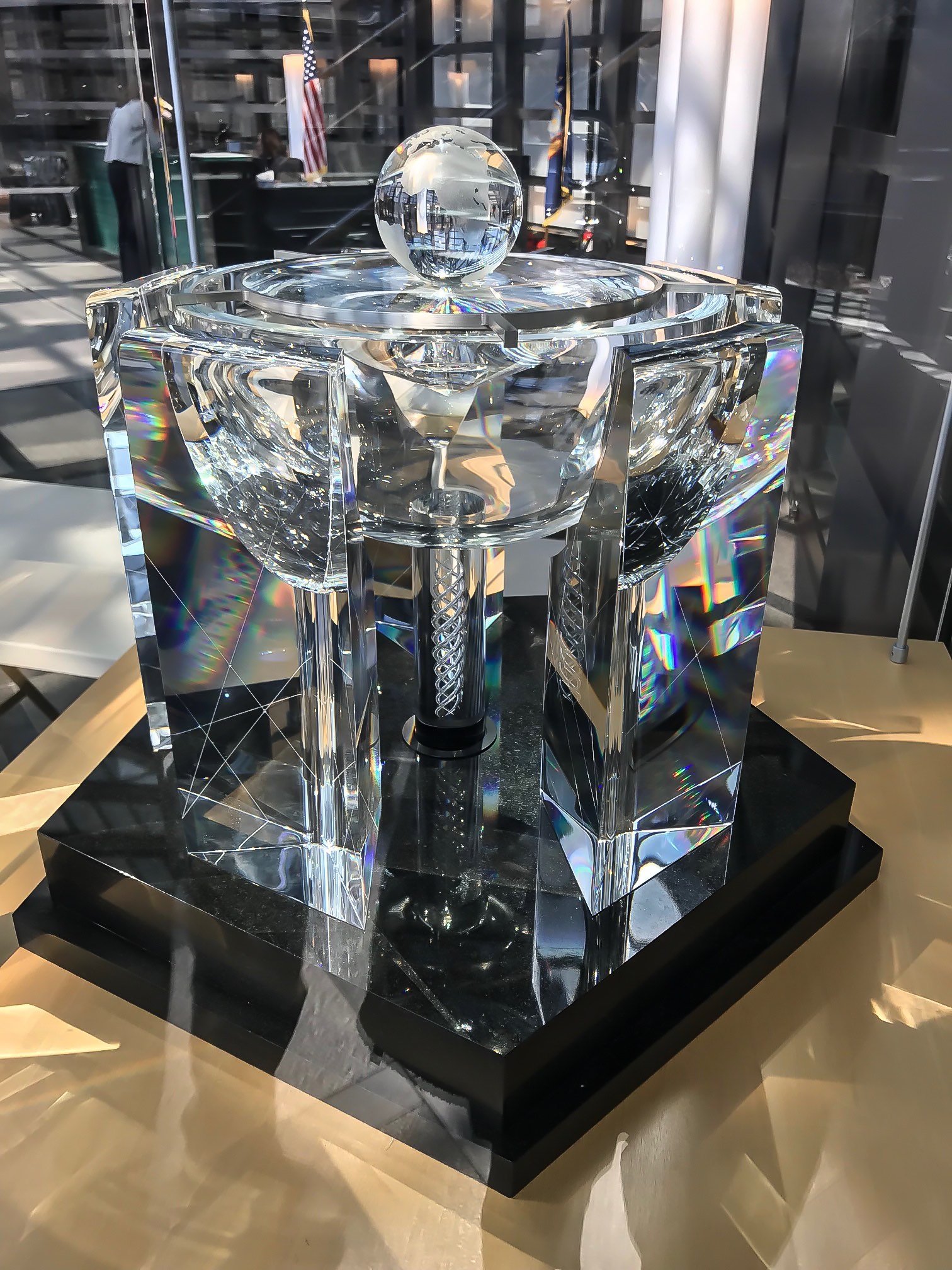

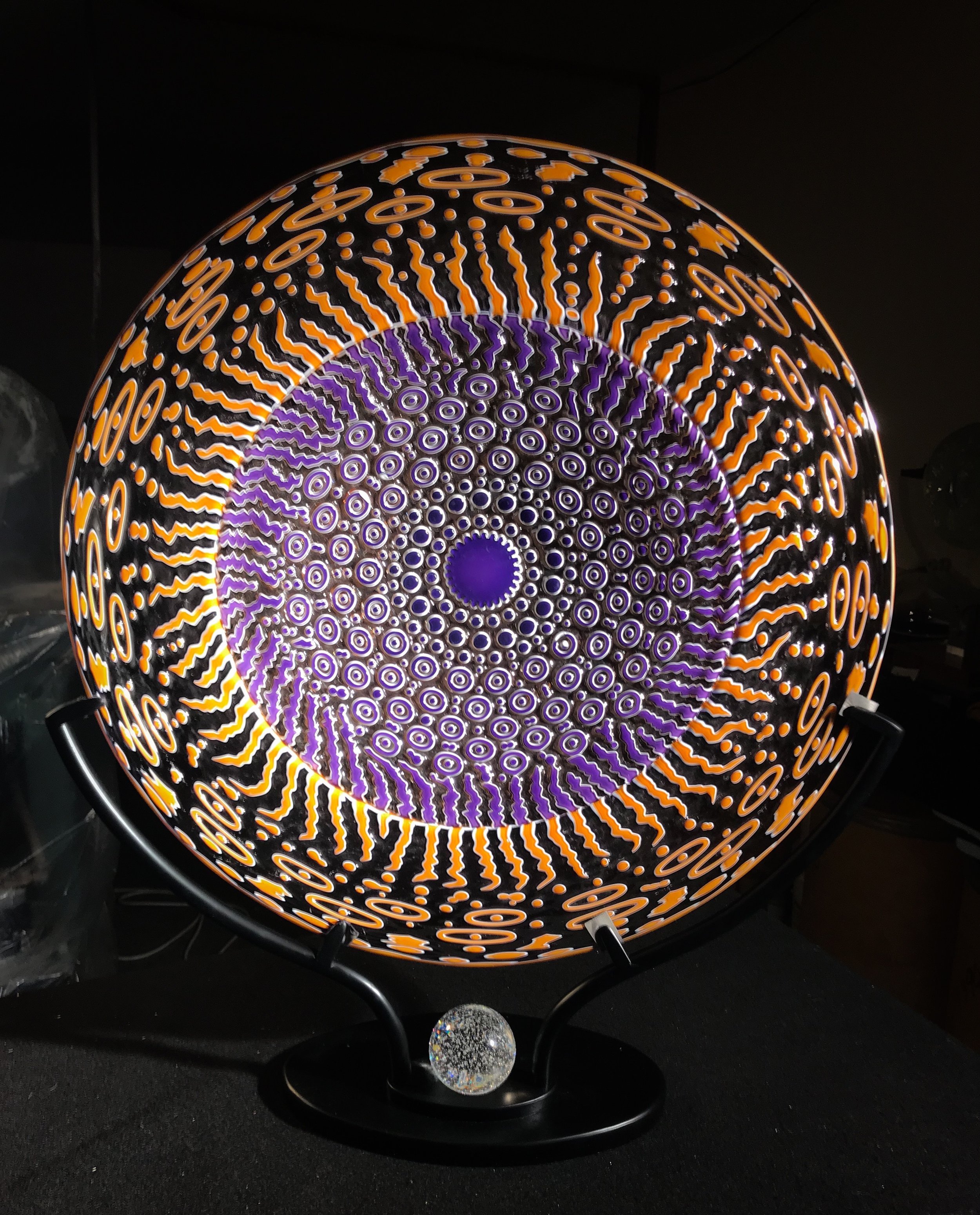
![CMoG Disc[1].jpg](https://images.squarespace-cdn.com/content/v1/5c72077dfb22a52ba7454db2/1639775384213-MFO521TNRY3CASO5EDZS/CMoG+Disc%5B1%5D.jpg)
